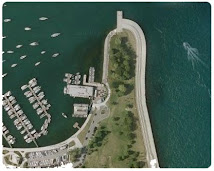The following will appear in Chicago Yacht Club's quarterly publication, The Blinker:
The International 505 class will return to Lake Michigan for the 2010 North American Championship; racing will be held at Belmont station June 24-27th. This event will mark Lake Michigan’s second 505 North American Championship. Waukegan Yacht Club hosted the event in 1978.
The 505 will bring an exciting level of performance and sailing skill to Chicago’s Lakefront. First designed by John Westell in 1953; the 505 has changed with the times and has been at the fore-front of sailboat materials and technology throughout its years. The two-man, single trapeze, centerboard dinghy specifies a minimum weight of roughly 280 lbs (127.4 kilos) with all equipment less sails. Unlike many high-performance dinghies, the 505 continues to use a symmetric spinnaker. This makes downwind sailing challenging and tactical as both “wire-running” (reaching) and running can be effective tactics. High-tech Kevlar and technora sails are common along with carbon booms and spinnaker poles. Many of the boats themselves are constructed with Kevlar and carbon over a nomex honeycomb or foam core and epoxy. This makes the boats capable of handling punishing loads and lasting decades longer than flimsy Lasers or 470s.
Along with the materials that 505 manufacturers and sailors use in construction, the class has maintained an open mind when it comes to rigging. Essentially, you can rig your 505 just about anyway you want. This freedom does not necessarily make the 505 complex; in fact many 505 sailors rig the boat simply. The most important thing about rigging your 505 is, whatever you put on the boat, make sure it works in 25 kts.
While some freedoms are allowed under class rules, the 505 is not a true development class in the image of an International 14. Measurement is an integral part of major events. Over the years, the 505 class has made careful changes to its rules always in an effort to maximize the enjoyment of sailing the boat.
The pure joy of sailing a 505 has drawn many of sailing’s greatest to the class throughout its existence. Paul Elvstrom won the 2nd and 3rd World Championships, Cam Lewis was a two time champion, Chris Nicholson a three time champion, Morgan Larson and Howard Hamlin are also winners among many other great dinghy sailors and 505 champions. The 2009 505 World Championship, held at St. Francis Yacht Club in San Francisco was won by Mike Martin and Jeff Nelson. Mike is the only man to win as both a crew and this year as helm. Among the 2009 fleet were sailing legend Paul Cayard, Howard Hamlin, 1981 505 World Champion Ethan Bixby, 2003 Rolex Yachtsman of the year Augie Diaz and the above mentioned multiple World Champion Chris Nicholson. The balance of the fleet is filled with College Sailors of the Year and many college All-Americans. The fleet was also filled with many of the best dinghy sailors from Australia, Great Britain, and Germany.
Those Chicago Yacht Club members willing to lend a hand or who simply want to watch will witness something different than the Area III standard. The 505 class uses a gate-launch or “rabbit” start. This procedure uses the standard 5 minute countdown from the RRS. There is however, no fixed starting line. The signal boat is anchored to leeward of the starting mark, at the start a designated “pathfinder” (a competing 505) rounds the starting mark and sails upwind on port tack. The pathfinder is followed by a motorboat, “the gate-launch” (usually a RIB). To start, a racing boat simply “ducks” the pathfinder and gate-launch, passing to windward of the starting mark. After a predetermined amount of time, the pathfinder is released and can race as he pleases. The gate-launch then may motor at the same speed and course until stopping and drifting depending on the size of the fleet. After a predetermined time, the start is closed and any competitor that has not passed through the gate is scored as DNS.
While this starting method may seem complex to the unfamiliar, in practice the system works remarkably well. There are essentially no recalls, the Race Committee does not have to set a “square” line, and the competitors love the system.
The 505 prides itself on the great cooperativeness and resourcefulness of the fleet. Traditionally, camping has been an option at events; obviously some compromises have to be made in our urban venue. The event organizers may be looking for willing members to house visiting competitors due to our obvious lack of camping options. There will be more information available for those willing and interested closer to the event date. Also, while the 505 fleet is generally self-sufficient, we will be looking for volunteers to help with some landside and potentially race-course oriented tasks. Again, we will have more on the specific needs closer to the event.
In the meantime, we are taking our 505s to Florida to get in a little time on the water while we are all frozen here in Chicago. After we thaw out, Chicago’s 505s will be hitting the water and we are always happy to take those interested in the boat for a ride. Please have a look at our local fleet website and the 2010 505 North American Championship website for more information on 505s and the upcoming event.
Event Chairmen: Craig Thompson (USA 7346) and JB Turney (USA 7611)
Thursday, December 17, 2009
Subscribe to:
Comments (Atom)









